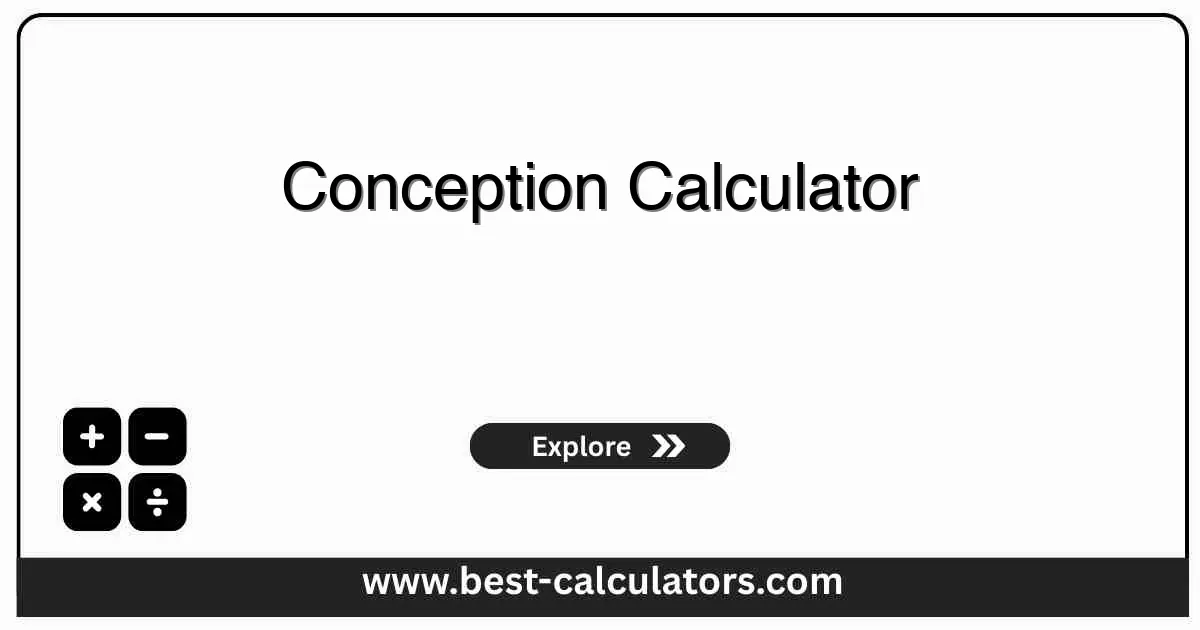Conception Calculator - Calculate Conception Date
Free conception calculator to estimate when conception occurred based on due date, last period, or ultrasound date for pregnancy tracking
Conception Calculator
Results
What is a Conception Calculator?
A Conception Calculator is a free pregnancy tool that estimates when conception occurred based on due date, last menstrual period, or ultrasound dating. It calculates the conception date and fertile window when fertilization most likely happened, helping track pregnancy timeline and identify possible conception dates for family planning.
This calculator works for:
- Pregnancy dating - Determine when conception occurred
- Paternity questions - Identify conception window timeframe
- Fertility tracking - Understand conception timing patterns
- Medical records - Calculate accurate pregnancy dates
To calculate ovulation and fertile days, check out our Ovulation Calculator to predict when conception is most likely to occur during your cycle.
For complete pregnancy tracking, explore our Pregnancy Calculator to determine due date, current week, and trimester based on conception or last period.
To track pregnancy progress, use our Pregnancy Due Date Calculator to estimate delivery date and important pregnancy milestones.
For gestational age tracking, try our Gestational Age Calculator to determine exact pregnancy weeks and days for medical appointments.
How Conception Calculator Works
The calculation uses standard pregnancy dating:
Calculation methods include:
- From Due Date = Due Date - 266 days (38 weeks)
- From Last Period = Last Period + 14 days (average ovulation)
- From Ultrasound = Ultrasound Date - (Gestational Age × 7) + 14 days
Conception typically occurs 11-21 days after the first day of last period, with most occurring around day 14 (ovulation). The conception window spans 5-7 days because sperm can survive 3-5 days in the reproductive tract. Pregnancy is officially dated from the first day of last menstrual period, not conception date.
Key Concepts Explained
Fertilization
Sperm penetrates egg in fallopian tube, creating a zygote. Occurs within 24 hours of ovulation. Fertilized egg travels to uterus over 5-7 days.
Implantation
Fertilized egg attaches to uterine lining 6-12 days after conception. Pregnancy hormone (hCG) production begins, detectable by pregnancy tests.
Gestational Age
Pregnancy age calculated from first day of last period, not conception. Two weeks longer than fetal age (conception age). Standard for medical dating.
Conception Window
5-7 day period when conception most likely occurred. Accounts for sperm survival time and ovulation timing variations. More accurate than single date.
How to Use This Calculator
Choose Calculation Method
Select whether to calculate from due date, last period, or ultrasound dating for most accurate results.
Enter Date Information
Input the relevant date (due date, last period, or ultrasound date with gestational age).
Calculate Results
Click Calculate to see estimated conception date, conception window, and pregnancy details.
Review Timeline
Use conception window to identify possible conception dates within the 5-7 day fertile period.
Benefits of Using This Calculator
- • Accurate Pregnancy Dating: Determine when conception occurred for medical records and pregnancy tracking.
- • Multiple Calculation Methods: Calculate from due date, last period, or ultrasound for flexibility and accuracy.
- • Conception Window: Identify 5-7 day period when conception most likely occurred, not just single date.
- • Family Planning: Understand conception timing for future pregnancy planning and fertility awareness.
- • Medical Appointments: Provide accurate conception dates for healthcare providers and prenatal care.
- • Free and Private: Calculate conception dates instantly without sharing personal information.
Factors That Affect Your Results
1. Cycle Regularity
Irregular cycles affect ovulation timing and conception date accuracy. Women with 28-day cycles have more predictable conception dates.
2. Ovulation Timing
Ovulation doesn't always occur on day 14. Early or late ovulation shifts conception date by several days from standard calculations.
3. Sperm Survival
Sperm can survive 3-5 days in reproductive tract. Intercourse several days before ovulation can still result in conception.
4. Ultrasound Accuracy
Early ultrasounds (6-12 weeks) are most accurate for dating. Later ultrasounds have larger margins of error for conception dating.
5. Multiple Ovulation
Rare cases of multiple ovulation in one cycle can affect conception timing. Fraternal twins result from two eggs fertilized separately.

Frequently Asked Questions (FAQ)
Q: How do I calculate my conception date?
A: Conception typically occurs 11-21 days after the first day of your last period, with most conceptions happening around 14 days after. From a due date, subtract 266 days (38 weeks) to estimate conception date. Conception occurs during the fertile window around ovulation.
Q: Can I determine the exact day of conception?
A: Exact conception day is difficult to pinpoint because sperm can survive 3-5 days in the reproductive tract. The calculator provides a conception window (typically 5-7 days) when conception most likely occurred. Ultrasound dating can narrow this window.
Q: How accurate is a conception calculator?
A: Conception calculators are 85-90% accurate for women with regular cycles. Accuracy improves with ultrasound dating. The calculator provides a conception window rather than exact date due to sperm survival time and ovulation timing variations.
Q: What is the difference between conception date and due date?
A: Conception date is when sperm fertilizes the egg, typically 2 weeks after last period. Due date is 40 weeks (280 days) from last period or 38 weeks (266 days) from conception. Pregnancy is dated from last period, not conception.
Q: Can conception happen outside the fertile window?
A: Conception is highly unlikely outside the fertile window (5 days before ovulation to ovulation day). However, cycle irregularities or unexpected ovulation can shift the fertile window. Sperm survival up to 5 days extends the conception possibility period.